1989 MITSUBISHI GALANT light
[x] Cancel search: lightPage 990 of 1273
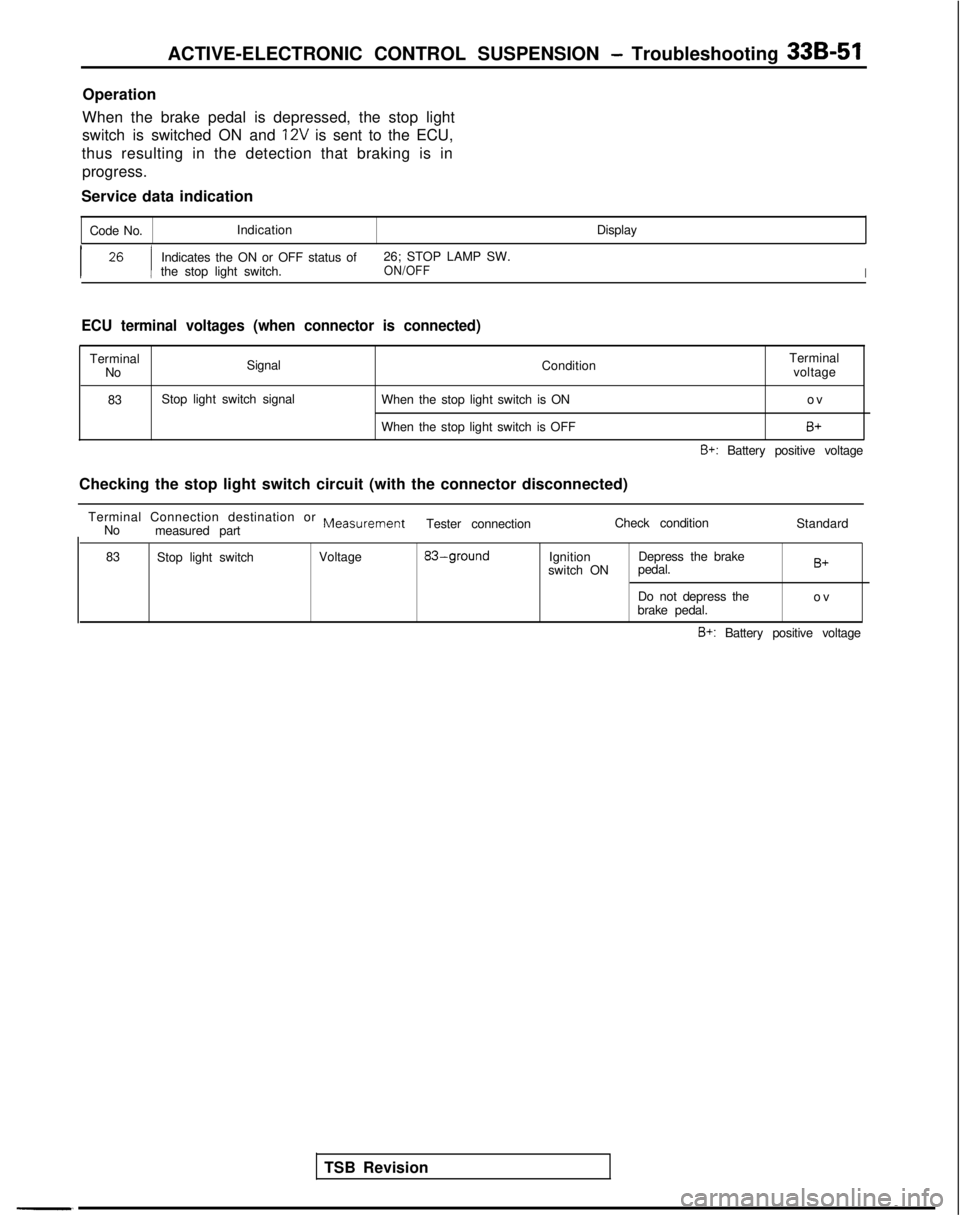
ACTIVE-ELECTRONIC CONTROL SUSPENSION - Troubleshooting 33B-51
Operation
When the brake pedal is depressed, the stop light
switch is switched ON and
1% is sent to the ECU,
thus resulting in the detection that braking is in progress.
Service data indication
Code No. Indication
Display
I 26 I
Indicates the ON or OFF status of26; STOP LAMP SW.
the stop light switch.ON/OFFI
ECU terminal voltages (when connector is connected)
Terminal Signal ConditionTerminal
No voltage
83 Stop light switch signal
When the stop light switch is ON o
v
When the stop light switch is OFF
B+
B+: Battery positive voltage
Checking the stop light switch circuit (with the connector disconnected\
) Terminal Connection destination or
MeasurementNo measured part Tester connection
Check condition
Standard
83 Stop light switch Voltage
83-groundIgnitionDepress the brake
switch ON pedal.B+
Do not depress the
o
v
brake pedal.
B+: Battery positive voltage
TSB Revision
-,
Page 991 of 1273
![MITSUBISHI GALANT 1989 Service Repair Manual 33B-52
ACTIVE-ELECTRONIC CONTROL SUSPENSION - Troubleshooting
[15] BACK-UP LIGHT SWITCH CIRCUIT Ignition switch (IG,)
c-43
-T----
From 1990 models 1989
models
C-23
-1
From 1990 models Junction
blo MITSUBISHI GALANT 1989 Service Repair Manual 33B-52
ACTIVE-ELECTRONIC CONTROL SUSPENSION - Troubleshooting
[15] BACK-UP LIGHT SWITCH CIRCUIT Ignition switch (IG,)
c-43
-T----
From 1990 models 1989
models
C-23
-1
From 1990 models Junction
blo](/manual-img/19/57312/w960_57312-990.png)
33B-52
ACTIVE-ELECTRONIC CONTROL SUSPENSION - Troubleshooting
[15] BACK-UP LIGHT SWITCH CIRCUIT Ignition switch (IG,)
c-43
-T----
From 1990 models 1989
models
C-23
-1
From 1990 models Junction
block
B-21
C-23 A
fiYl%mq
1989 models
F-lfi
& 12 *
c
2 12,16
ifi
Back-up
light switch
+ From 1990
models
*
To back-up
light
ECU12AO400
Checking the back-up light switch circuit (with the connector disconnec\
ted)
Terminal Connection destination or
,v,easurement TesterNo.measured Dartconnection Check condition
Standard
72Back-up light
Voltage72-groundWith the shift leverIgnition switch OFFo
v
shifted to the REVERSE position Ignition switch ON
B+
Service data indicationB+: Battery positive voltage
Code No. Indication Display
32Indicates the ON or OFF status of
32; M/T
BACK LAMP ON/OFF
the back-up light switch.
ECU terminal voltages (when connector is connected)
TerminalNoCondition Terminal
voltage
72Manual transaxle back-up signal
I
When the back-up light switch is ON
When the back-up light switch is OFF
1
1 TSB Revision
B+
o
v
I1B+: Battery positive voltage
Page 992 of 1273
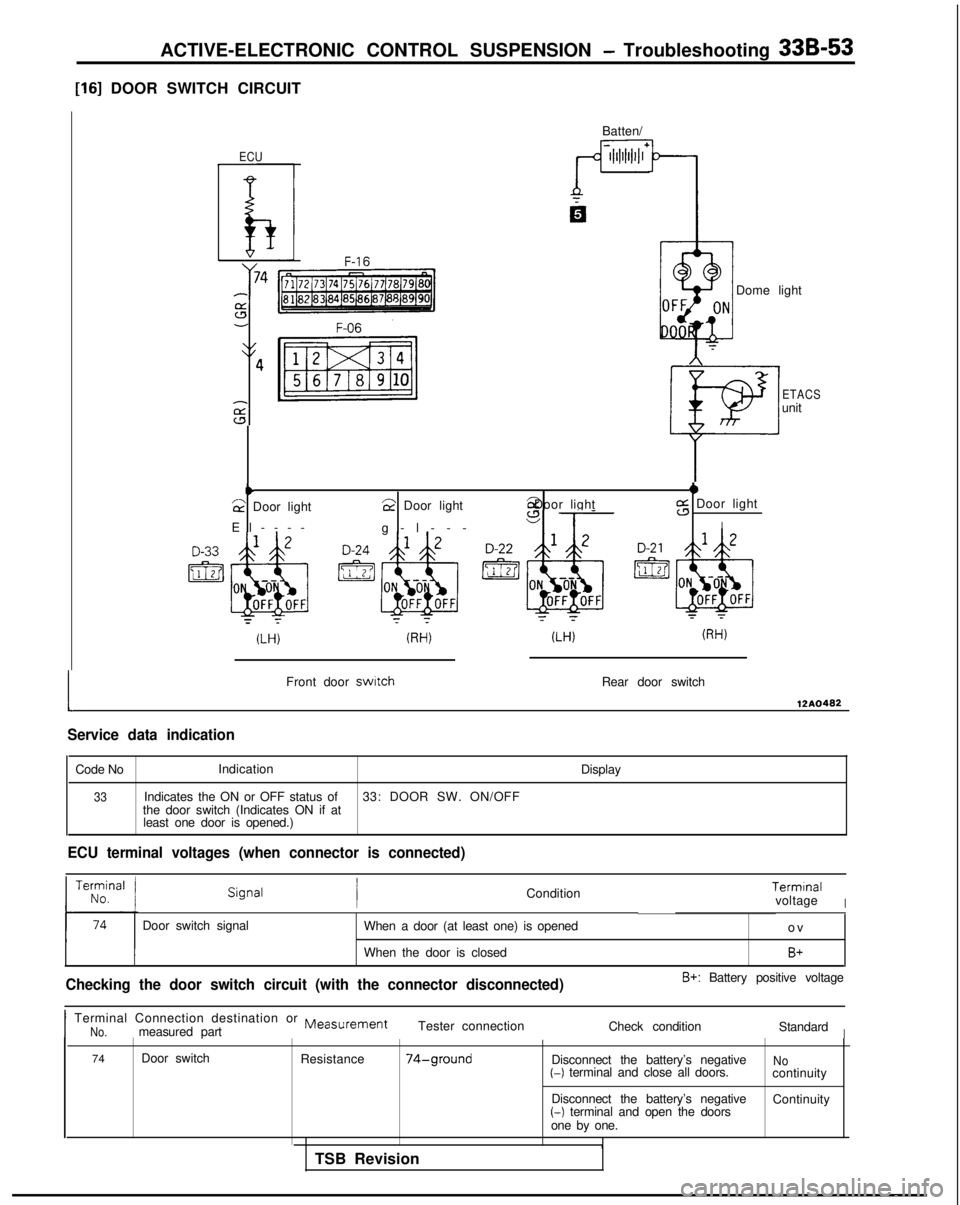
ACTIVE-ELECTRONIC CONTROL SUSPENSION - Troubleshooting 33B-53
1161 DOOR SWITCH CIRCUIT
L
ECU
Batten/
Dome light
ETACSunit
b +G Door light2 Door light
6? Door light
El---- g-l---
sl--
z Door light
I
Front door swatchRear door switch
Service data indication
Code NoIndication
Display
33Indicates the ON or OFF status of33: DOOR SW. ON/OFF
the door switch (Indicates ON if at least one door is opened.)
ECU terminal voltages (when connector is connected)
Condition Termrnal
voltageI
Door switch signal When a door (at least one) is opened
When the door is closed o
v
B+
Checking the door switch circuit (with the connector disconnected)B+: Battery positive voltage
ITerminal Connection destination or MeasurementNo.measured part
Tester connection
Check conditionStandardI
74Door switch
Resistance74-groundDisconnect the battery’s negative (-)
terminal and close all doors.
Disconnect the battery’s negative (-)
terminal and open the doors
one by one.Nocontinuity
Continuity
TSB Revision
Page 994 of 1273

ACTIVE-ELECTRONIC CONTROL SUSPENSION - Troubleshooting 33B-55
Operation
The damping force switching actuator is the step motor. That allows the control rod of each shock at one of four levels (HARD, MEDIUM, AUTO-SOFT
or SOFT).
absorber to rotate, thus selecting the damping force
Diagnostic
If there is damage or disconnection of the heavy-line
circuit, the alarm light illuminates, and control is as
described in the table below. (Because the
ac-
tuators are connected in parallel, there can be no detection if wiring damage or disconnection occurs
at the final circuit.)
Diagnostic No.Attitude control
41Control stop
Actuator compulsory activation
Damplng forcecontrol
Control stop Vehicle-height
control
Held at NORMALHIGH
Switch acceptance
SPORT AUTO
Not accept
SOFT
Code No.Applrcable operatron Descriptron
of activation
01SOFT damplng force The damplng force is compulsorily swltched to SOFT: there is a return to theonginal damping force three seconds thereafter
02AUTO-SOFT damping force The damping force is compulsorily switched to AUTO-SOFT; there is a return to
the onginal damping force three seconds thereafter
03 MEDIUM damping force The damping force is compulsorily switched to MEDIUM; there is a return \
to the
onginal damping force three seconds thereafter
04 HARD
damplng force The damping force IS compulsorily switched to HARD; there IS a return to theonginal damping force three seconds thereafter
ECU terminal voltages (when connector is connected) Terminal
No
Slgnal
Condition Terminal
voltage
1Damping force swrtchlng
actuatoractlvatlon signal When the damping force switching actuator IS stopped6V
Phase AO=B+2p When the damping force switching actuator is activated
Damping force switching actuator
activation signal
Phase
BWhen wiring is damaged or dlsconnectedB+
6 Damplng
force switchrng
actuatoractivation slgnal
When the damping force switching actuator IS stopped 6V
Phase C
7p When the damping force switching actuator is activated
Damping force switching actuatorB+ = 0 pulse
activation signal
Phase DWhen wiring is damaged or disconnected o
v
B+: Battery positive voltage
Checking the damping force switching actuator drive circuit (with the c\
onnector disconnected)
TSB Revision
Terminal Connection
destination or MeasurementNomeasured part
Tester connection
Check condltlonStandard1
ADamping force switching Resistance 1-6
Four coils that have a constant
actuator (step motor)Approx
resistance of 6.4 i-O.1 ohms are 1611
connected in parallel (front and rear)
2Damping force swltchlng Resistance 2-7
Four coils that have a constant7actuator (step motor) Approx.
resistance of 6.4 t 0.1 ohms are1.612connected in parallel (front and rear).
Page 996 of 1273
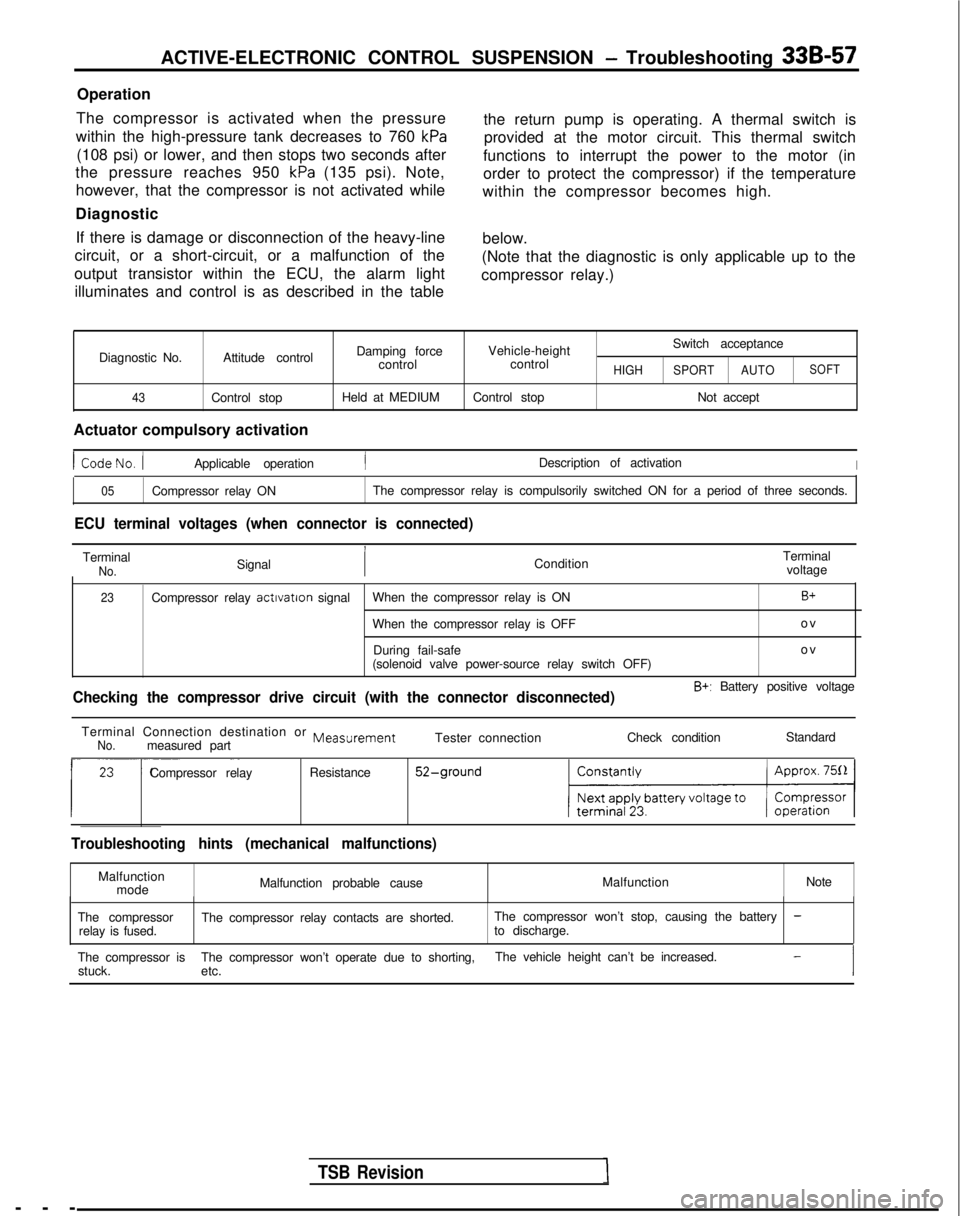
ACTIVE-ELECTRONIC CONTROL SUSPENSION - Troubleshooting 33B-57
Operation
The compressor is activated when the pressure
within the high-pressure tank decreases to 760
kPa
(108 psi) or lower, and then stops two seconds after
the pressure reaches 950
kPa (135 psi). Note,
however, that the compressor is not activated while
Diagnostic If there is damage or disconnection of the heavy-line
circuit, or a short-circuit, or a malfunction of the
output transistor within the ECU, the alarm light illuminates and control is as described in the table the return pump is operating. A thermal switch is
provided at the motor circuit. This thermal switch
functions to interrupt the power to the motor (in
order to protect the compressor) if the temperature
within the compressor becomes high.
below.
(Note that the diagnostic is only applicable up to the
compressor relay.)
Diagnostic No.
43
Attitude control
Control stop Damping force
control
Held at MEDIUM Vehicle-height
control
Control stopHIGH
Switch acceptance
SPORT AUTOSOFT
Not accept
Actuator compulsory activation
1 CodeNo. /Applicable operationIDescription of activationI
05Compressor relay ON The compressor relay is compulsorily switched ON for a period of three s\
econds.
ECU terminal voltages (when connector is connected)
TerminalNo.Signal ConditionTerminal
voltage
23Compressor relay actrvatron
signal When the compressor relay is ONB+
When the compressor relay is OFF o
v
During fail-safe ov
(solenoid valve power-source relay switch OFF) ---
TSB Revision
Checking the compressor drive circuit (with the connector disconnected)\
B+: Battery positive voltage
Terminal Connection destination or
MeasurementNo.measured part Tester connection
Check conditionStandard
~~
Compressor relay Resistance52-ground
Troubleshooting hints (mechanical malfunctions)
Malfunction
mode Malfunction probable cause
Malfunction
Note
The compressor relay is fused. The compressor relay contacts are shorted.
The compressor won’t stop, causing the battery
-to discharge.
The compressor is The compressor won’t operate due to shorting, The vehicle height can’t be increased.
-
stuck.
etc.
Page 1000 of 1273
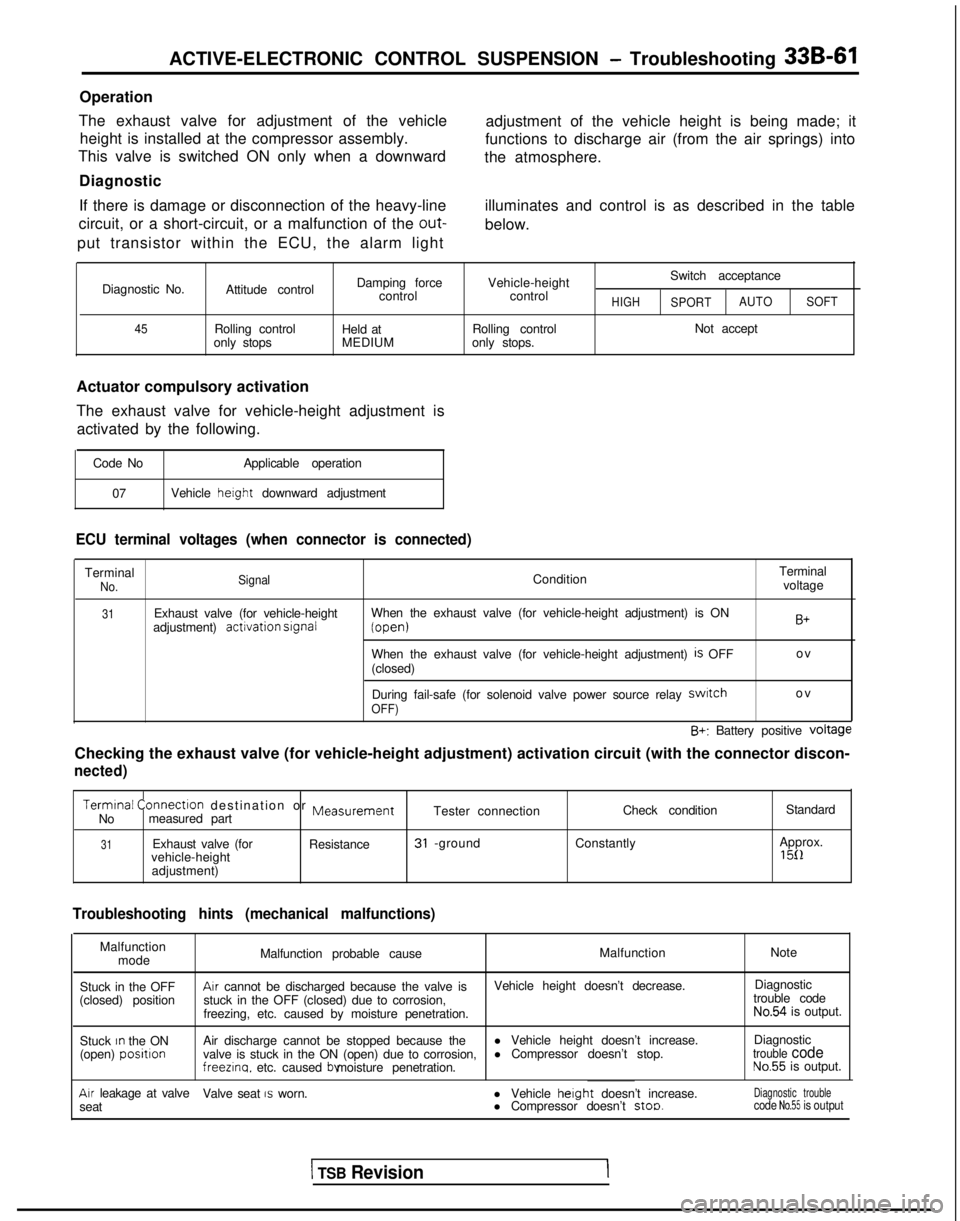
ACTIVE-ELECTRONIC CONTROL SUSPENSION - Troubleshooting 33B-61
Operation
The exhaust valve for adjustment of the vehicle height is installed at the compressor assembly.
This valve is switched ON only when a downward
Diagnostic
If there is damage or disconnection of the heavy-line
circuit, or a short-circuit, or a malfunction of the out-
put transistor within the ECU, the alarm light adjustment of the vehicle height is being made; it
functions to discharge air (from the air springs) into
the atmosphere.
illuminates and control is as described in the table
below.
Diagnostic No.
45
Attitude control
Rolling control
only stops Damping force
control
Held at
MEDIUM Vehicle-height
control
Rolling control
only stops. Switch acceptanceHIGHSPORT
AUTO
SOFT
Not accept
Actuator compulsory activation
The exhaust valve for vehicle-height adjustment is activated by the following.
Code No Applicable operation
07 Vehicle height
downward adjustment
ECU terminal voltages (when connector is connected)
TerminalNo. SignalCondition Terminal
voltage
31Exhaust valve (for vehicle-height
adjustment) activation srgnalWhen the exhaust valve (for vehicle-height adjustment) is ON (open)
When the exhaust valve (for vehicle-height adjustment)
is OFF
(closed)
B+
o
v
During fail-safe (for solenoid valve power source relay
swatcho
v
OFF)
B+: Battery positive voltage
Checking the exhaust valve (for vehicle-height adjustment) activation \
circuit (with the connector discon-
nected)
Termtnal
Connectlon destination or MeasurementCheck condition Standard
No measured part Tester connection
31Exhaust valve (for
Resistance31 -groundConstantly Approx.
vehicle-height1511adjustment)
Troubleshooting hints (mechanical malfunctions)
Malfunction mode Malfunction probable cause
Malfunction
Note
Stuck in the OFF
Arr cannot be discharged because the valve is Vehicle height doesn’t decrease.Diagnostic
(closed) position stuck in the OFF (closed) due to corrosion, trouble code
freezing, etc. caused by moisture penetration.
No.54 is output.
Stuck
rn the ON
(open) positlonAir discharge cannot be stopped because the l Vehicle height doesn’t increase.Diagnostic
valve is stuck in the ON (open) due to corrosion, l Compressor doesn’t stop.trouble codefreezlna.
etc. caused bv moisture penetration.No.55 is output.
Arr leakage at valve
Valve seat IS worn.
seat l Vehicle herght
doesn’t increase.
l Compressor doesn’t stoo.Diagnostic troublecode No.55 is output
1 TSB Revision
Page 1002 of 1273
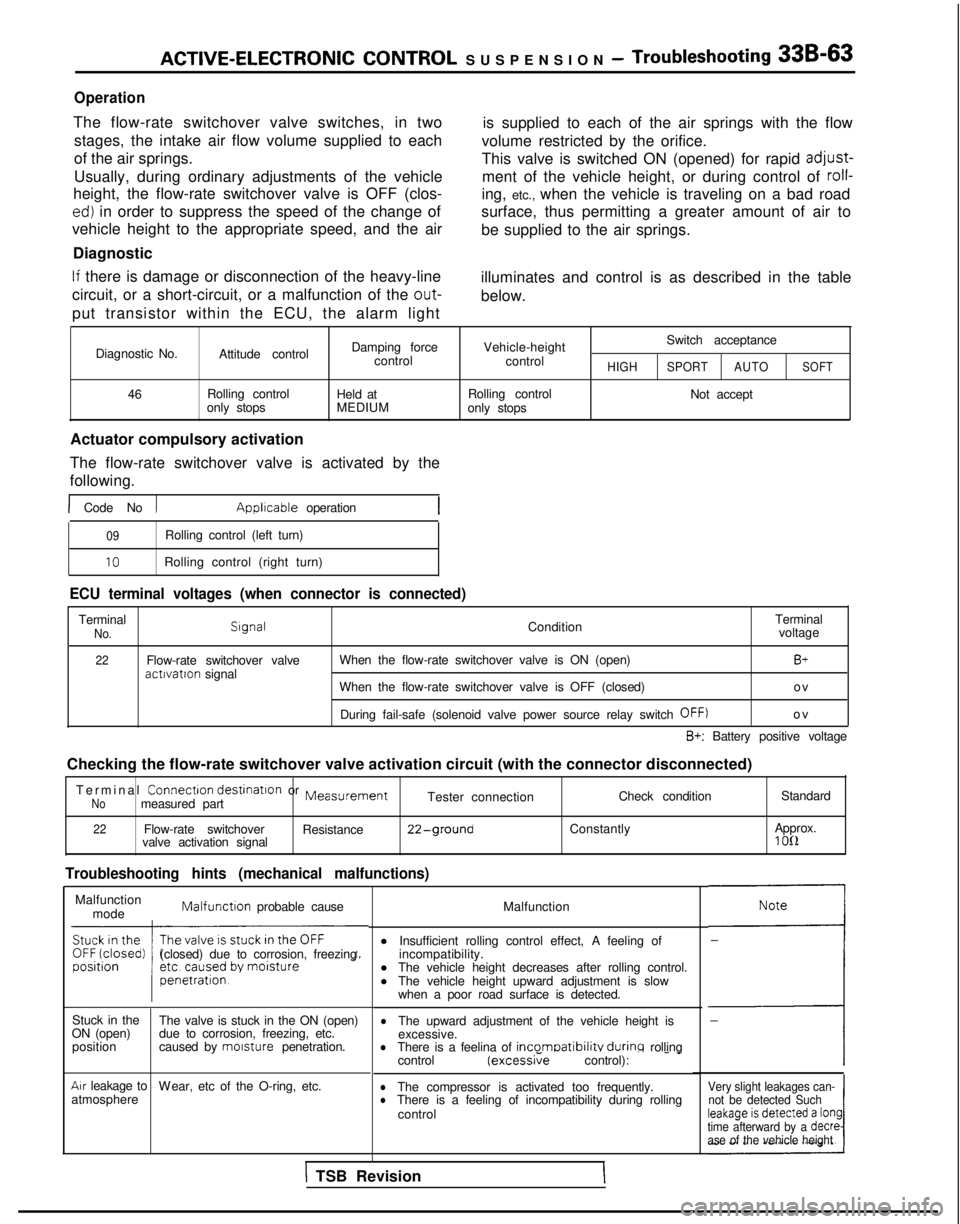
ACTIVE-ELECTRONIC CONTROL SUSPENSION - Troubleshooting 3%~63
Operation
The flow-rate switchover valve switches, in twostages, the intake air flow volume supplied to each
of the air springs.
Usually, during ordinary adjustments of the vehicle
height, the flow-rate switchover valve is OFF (clos-
ed) in order to suppress the speed of the change of
vehicle height to the appropriate speed, and the air
Diagnostic is supplied to each of the air springs with the flow
volume restricted by the orifice.
This valve is switched ON (opened) for rapid
adjust-
ment of the vehicle height, or during control of roll-
ing, etc., when the vehicle is traveling on a bad road
surface, thus permitting a greater amount of air to
be supplied to the air springs.
If there is damage or disconnection of the heavy-line illuminates and control is as described in the table
circuit, or a short-circuit, or a malfunction of the out-
below.
put transistor within the ECU, the alarm light
Switch acceptance
Diagnostic No. Attitude control Damping force
Vehicle-height
control control
HIGHSPORT AUTOSOFT
46 Rolling control
Held at Rolling control
Not accept
only stops MEDIUM
only stops
Actuator compulsory activation
The flow-rate switchover valve is activated by the
following.
1 Code No 1 Applrcable
operation
09Rolling control (left turn)
10Rolling control (right turn)
ECU terminal voltages (when connector is connected)
TerminalNo.SrgnalCondition Terminal
voltage
22Flow-rate switchover valve actrvation
signal When the flow-rate switchover valve is ON (open)B+
When the flow-rate switchover valve is OFF (closed)
o
v
During fail-safe (solenoid valve power source relay switch
OFF)o
v
B+: Battery positive voltage
Checking the flow-rate switchover valve activation circuit (with the co\
nnector disconnected) Terminal Connectron
destinatron
or
MeasurementNomeasured part Tester connection
Check condition
Standard
22Flow-rate switchover
Resistance22-groundConstantly Approx.
valve activation signal1 OIL
Troubleshooting hints (mechanical malfunctions)
Malfunction mode Malfunctron
probable cause
(closed) due to corrosion, freezing
Stuck in the The valve is stuck in the ON (open)
ON (open) due to corrosion, freezing, etc.
position caused by morsture
penetration.
Arr leakage to
W
ear, etc of the O-ring, etc.
atmosphere Malfunction
l Insufficient rolling control effect, A feeling of
incompatibility.
l The vehicle height decreases after rolling control.
l The vehicle height upward adjustment is slow
when a poor road surface is detected.
lThe upward adjustment of the vehicle height is
excessive.
lThere is a feelina of incomoatibilitv durinq rolling
control (excessi;e control): - -
lThe compressor is activated too frequently.lThere is a feeling of incompatibility during rolling
control
“i
4
-
Very slight leakages can-not be detected Such
time afterward by a
decre
ase of the vehicle height
\ TSB Revision
Page 1004 of 1273
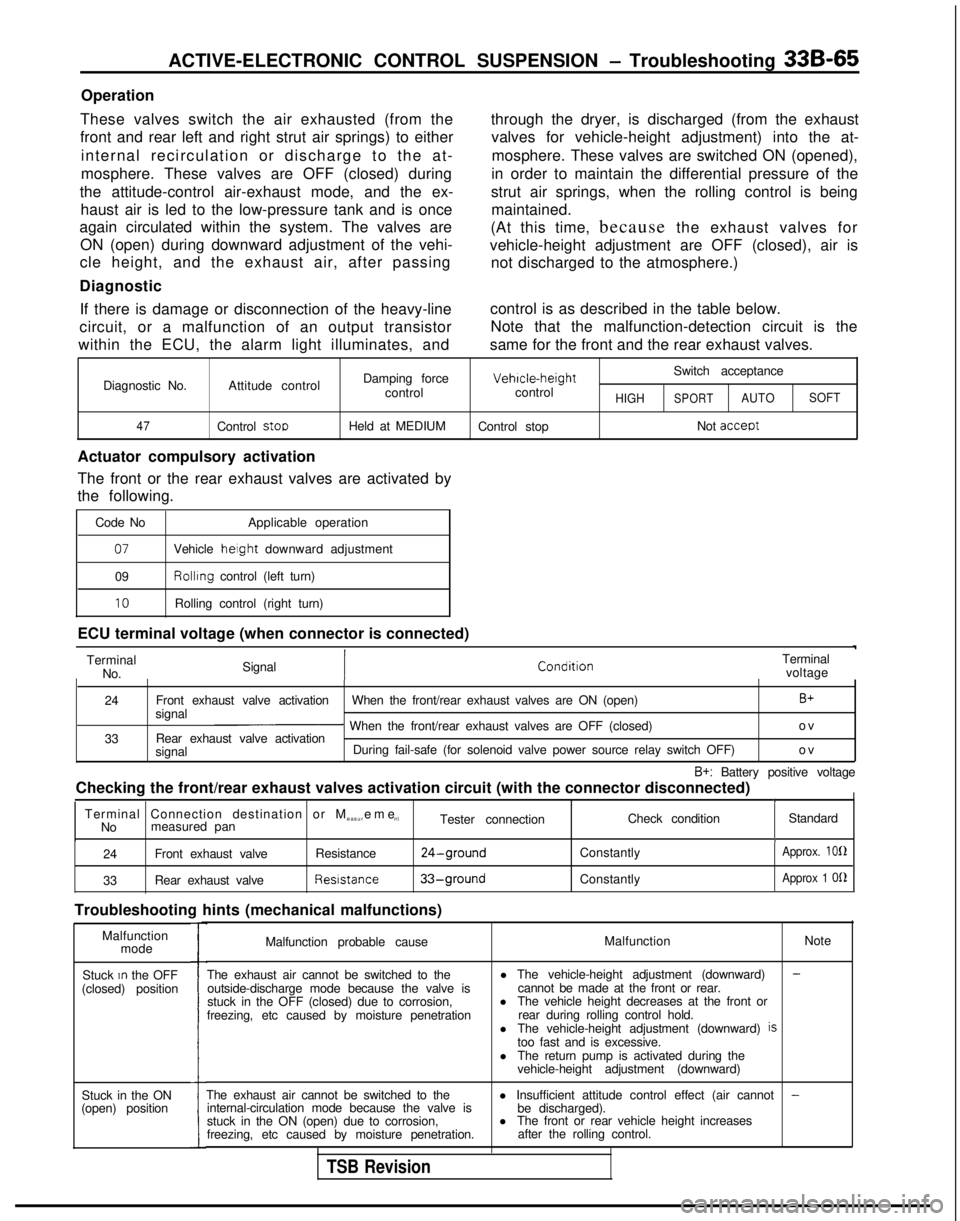
ACTIVE-ELECTRONIC CONTROL SUSPENSION - Troubleshooting 33B-65
Operation
These valves switch the air exhausted (from the
front and rear left and right strut air springs) to either internal recirculation or discharge to the at-
mosphere. These valves are OFF (closed) during
the attitude-control air-exhaust mode, and the ex- haust air is led to the low-pressure tank and is once
again circulated within the system. The valves are
ON (open) during downward adjustment of the vehi-
cle height, and the exhaust air, after passing
Diagnostic through the dryer, is discharged (from the exhaust
valves for vehicle-height adjustment) into the at-
mosphere. These valves are switched ON (opened),
in order to maintain the differential pressure of the
strut air springs, when the rolling control is being maintained.
(At this time, because the exhaust valves for
vehicle-height adjustment are OFF (closed), air is not discharged to the atmosphere.)
If there is damage or disconnection of the heavy-line control is as described in the table below.
circuit, or a malfunction of an output transistor Note that the malfunction-detection circuit is the
within the ECU, the alarm light illuminates, and same for the front and the rear exhaust valves.
Damping force Vehrcle-height
Switch acceptance
Diagnostic No. Attitude control
controlcontrol
HIGHSPORTAUTOSOFT
47
Control stooHeld at MEDIUM Control stop Not acceot
Actuator compulsory activation
The front or the rear exhaust valves are activated by
the following.
Code No Applicable operation
07Vehicle height downward adjustment
09 Rollrng
control (left turn)
10Rolling control (right turn)
ECU terminal voltage (when connector is connected) Terminal No. Signal Terminal
voltage
24
33 Front exhaust valve activation
When the front/rear exhaust valves are ON (open)
B+signal~ When the front/rear exhaust valves are OFF (closed) o
v
Rear exhaust valve activation
signal During fail-safe (for solenoid valve power source relay switch OFF)
ov
B+: Battery positive voltage
Checking the front/rear exhaust valves activation circuit (with the con\
nector disconnected)
II ITerminal Connection destination or M
easurem
e
nt
No measured pan Tester connection
Check condition
Standard
I
24Front exhaust valve Resistance24-ground
33Rear exhaust valve Resistance33-ground
Troubleshooting hints (mechanical malfunctions)
Constantly
Constantly
Approx. 100
Approx 1
OQ
Malfunction mode
Stuck
In the OFF
(closed) position
Stuck in the ON
(open) position
I
Malfunction probable cause Malfunction
Note
The exhaust air cannot be switched to the outside-discharge mode because the valve is
stuck in the OFF (closed) due to corrosion,
freezing, etc caused by moisture penetration l The vehicle-height adjustment (downward)
-cannot be made at the front or rear.
l The vehicle height decreases at the front or
rear during rolling control hold.
l The vehicle-height adjustment (downward)
istoo fast and is excessive.
l The return pump is activated during the
vehicle-height adjustment (downward)
The exhaust air cannot be switched to the l Insufficient attitude control effect (air cannot
-internal-circulation mode because the valve is
be discharged).
stuck in the ON (open) due to corrosion, l
The front or rear vehicle height increases
freezing, etc caused by moisture penetration. after the rolling control.
TSB Revision